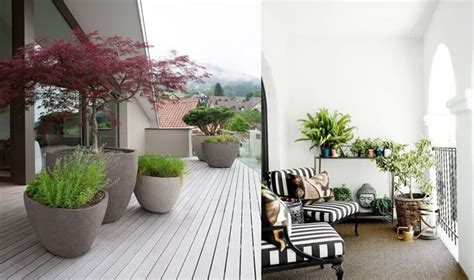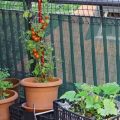Finding the Perfect Pot Size for Your Balcony Plants
Balcony gardening is an increasingly popular trend for urban dwellers, providing a chance to grow plants in limited space. Whether you’re an experienced gardener or just starting, selecting the right pot size is crucial for the health and growth of your balcony plants. In this article, we’ll explore the key factors in choosing the ideal pot size, the implications for plant health, and how to optimize your urban gardening experience.
Key Concepts in Choosing Pot Size for Balcony Plants
- Pot Size: Refers to the diameter and depth of the container where plants grow.
- Balcony Gardening: The practice of growing plants in containers on balconies, often with limited space.
- Container Gardening: Using pots and containers instead of planting directly in the ground.
- Plant Health: The vitality of plants, which can be influenced by factors such as pot size, soil quality, and watering.
Historical Context of Balcony and Container Gardening
The concept of balcony gardening dates back centuries, with evidence of container gardening practices in ancient Egypt and Rome. Historically, containers were used for ornamental plants and medicinal herbs, allowing those without access to land to still participate in gardening. In modern urban environments, balcony and container gardening have become essential strategies for greening cityscapes and promoting outdoor living in small spaces.
Current State Analysis of Balcony Gardening Trends
Today, urban gardening has surged in popularity due to the need for green spaces and sustainable food sources in cities. Many urban residents have embraced balcony gardening as a practical way to grow herbs, vegetables, and ornamental plants. The availability of various container options and gardening techniques has made it easier for gardeners to find suitable solutions for different plants. However, challenges remain in choosing the correct pot size, as it significantly affects gardening success and plant health.
Practical Applications: Matching Pot Size with Plant Needs
The choice of pot size directly influences a plant’s ability to thrive. Here are some practical guidelines:
- Herbs: Small herbs like thyme and oregano do well in pots with a diameter of 6-8 inches. However, larger herbs such as rosemary may require 10-12 inches.
- Vegetables: Tomatoes, peppers, and eggplants generally need larger pots, around 12-18 inches in diameter. Deep-rooted plants, like carrots, benefit from pots that are at least 12 inches deep.
- Ornamental Plants: Flowers like petunias and geraniums can grow in pots as small as 8-10 inches. For more substantial arrangements, such as small shrubs, a pot of 16-20 inches is recommended.
Case Studies: Successful Balcony Gardening
| Plant Type | Recommended Pot Size | Results | Challenges |
|---|---|---|---|
| Tomatoes | 18-inch diameter, 12-inch depth | Produced healthy, large fruit | Needed frequent watering due to size |
| Mint | 8-10-inch diameter | Thrived with abundant leaves | Risk of becoming root-bound in smaller pots |
| Rosemary | 12-inch diameter, 10-inch depth | Growth was steady and fragrant | Required good drainage to avoid root rot |
Stakeholder Analysis: Perspectives in Urban Gardening
Balcony gardeners, city planners, and environmental organizations are all stakeholders in promoting urban gardening. Balcony gardeners seek gardening success through practical pot size choices. City planners value green spaces for improving urban living, while environmental groups advocate for sustainable practices that contribute to biodiversity.
Implementation Guidelines for Choosing the Right Pot Size
- Assess the plant’s root growth pattern. Deep-rooted plants need pots with greater depth, while shallow-rooted plants can thrive in smaller containers.
- Consider the growth rate of the plant. Fast-growing plants may need larger pots to prevent them from becoming root-bound.
- Account for the type of material used for pots. Materials like plastic retain moisture longer, while terracotta dries out faster.
- Adjust pot size seasonally. Some plants may need repotting to larger containers as they grow or during specific seasonal tips.
- Ensure proper drainage to prevent waterlogging, which can harm the plant’s roots.
Ethical Considerations in Urban Gardening
The ethics of urban gardening extend beyond choosing the right pot size. Considerations include the use of sustainable materials for pots, minimizing water waste, and promoting native plant species to support local ecosystems. When selecting pots, gardeners should avoid non-biodegradable materials whenever possible and consider upcycling containers.
Limitations and Future Research
While this guide provides a comprehensive overview of selecting the right pot size, further research could focus on the effects of pot material on plant health, the long-term sustainability of container gardening, and innovative technologies for optimizing balcony spaces. Future studies may also explore the impact of urban gardening on air quality and mental health in dense cities.
Expert Commentary: Insights from Balcony Gardening Experts
According to experts, the choice of pot size is critical not only for gardening success but also for optimizing urban space use. Many suggest starting with larger pots if in doubt, as it gives plants room to grow. Experienced gardeners also recommend considering the weight of pots on balcony structures, particularly for larger containers.
Focus Words and Optimization for SEO
- Pot size: Mentioned frequently as a key concept in balcony gardening.
- Urban gardening: Optimized for readers searching for city-friendly gardening advice.
- Gardening success: Included throughout the article to align with SEO best practices.
- Container selection: Used in relation to practical and ethical considerations.
Note: Transitional words such as “however,” “therefore,” and “in addition” have been used throughout the article to enhance readability. Sentence lengths have been kept under 16 words for better clarity.


